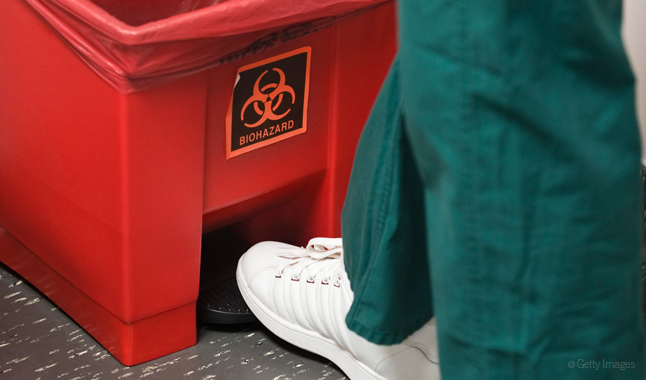5 reasons you need an infection prevention coordinator
Having an infection prevention coordinator can help ensure that your practice stays up to date on infection control issues.
Infection control is a multi-headed monster, and fighting it may seem like an uphill battle. Your dental practice must be attentive to a diverse range of issues, including the proper use of personal protective equipment, hand hygiene and equipment sterilization. Add to that, there are also regulatory and compliance issues that are constantly changing.

With so many moving parts, it’s easy for something to fall through the cracks, which is why it is important to have an infection prevention coordinator designated by the practice to ensure that everything gets the attention it requires.
The Centers for Disease Control and Prevention in its 2016 Summary of Infection Prevention Practices in Dental Settings says as much.
Trending article: 6 scary consequences of not following good infection control practices
“At least one individual with training in infection prevention - the infection prevention coordinator - should be responsible for developing written infection prevention policies and procedures based on evidence-based guidelines, regulations or standards,” the summary reads. “Policies and procedures should be tailored to the dental setting and reassessed on a regular basis (e.g., annually) or according to state or federal requirements.”
We talked to infection control experts to find out some of the important reasons to have an infection prevention coordinator.
Click through the slides to learn more.


The point person
Somebody has to be designated within the practice to handle all of the varied responsibilities demanded by infection control.
“It’s like when you call 911 in an emergency,” says Joyce Moore, RDH, an infection control consultant and clinical instructor at Bristol Community College in Fall River, Massachusetts. “Somebody has to be designated because otherwise everybody else thinks that the job is getting done, and then you have an incident and you find out that it’s not.”
More from the author: 5 ways procedures are changing because of bulk fill technologies
“It’s definitely important to have a point person,” says Mary Borg-Bartlett, president of SafeLink Consulting. “Not only have we seen new policies issued, but even regulatory changes. An example is the changeover from MSDSs to Safety Data Sheets, which takes time to replace. Other examples would be ensuring that radiation permits are current and licenses are up to date. So, a practice needs someone who stays educated and up to date on safety. OSHA requires employers to provide a safe workplace.”
Many details have the opportunity to fall through the cracks, and that point person can make sure these specifics are attended to. For instance, Moore calls attention to personal protective equipment.
“You have to not only make sure that is provided, but that those things are enforced,” Moore says. “So, you can have staff that may say, ‘I don’t want to wear my lab coat, I’m too warm,’ but enforcement needs to be there because the risk is too high. So, in addition to someone that is checking compliance and making sure immunizations are up to date, making sure there’s training and education, we need to make sure that there is someone there to tie all these pieces together.”



Mitigating damages
The most important reason to manage infection control is just as the name suggests – to reduce chances for infection. Designating someone as the infection prevention coordinator helps orchestrate the practice’s efforts to that end.
“It’s important to have that infection prevention coordinator to ensure that infection control practices are being followed in order to prevent the patient and workers from contracting a disease,” Borg-Bartlett observes.
Related reading: The challenges of waterline disinfection
“Infection control breaches are definitely a risk to our patients, but there are also risks to us as providers,” Moore says. “There are some significant diseases that may not be detected until years later, so we have to protect ourselves.”
An infection control breach poses other threats, in addition to the obvious physical ones. For instance, the government could levy penalties and, maybe even worse, there is the risk to one’s reputation.
“We have professionals – we have dentists, hygienists, assistants – who invest in years and years of training,” Moore says. “Many, many years of building a practice, having those patient relationships, and just one significant breach can sever that relationship. Marketing is not necessarily going to get you past that. Will the trust to be broken and will you still have the business and be able to provide the patient care without folks having doubts?”



Staff education and accountability
Because infection control encompasses so many details, it is especially important for one person to coordinate all of those efforts.
“By having someone accountable for that function and making it an integral part of their job, the practice has a resource for training purposes,” Borg-Bartlett says. “The effectiveness of this person’s position should be evaluated in their performance reviews.”
Things change, and in addition to the fluctuating face of regulation, new infectious disease threats arise. Equipment new and old must be properly maintained.
Trending article: 10 reasons dentists should be thankful for hygienists and assistants
“You need someone who stays up to date on infectious diseases and how to prevent them,” Borg-Bartlett says.
The CDC recommends a periodic review, while OSHA’s Bloodborne Pathogens standard requires a yearly review of the Exposure Control Plan.
“In my opinion, evaluating whether or not staff is practicing good hand hygiene shouldn’t wait for an annual review,” Borg-Bartlett observes. “So, you have someone who is continuously evaluating the safe practices that are being performed by the dental staff.”
That infection prevention coordinator can ensure that everyone is doing things the right way.
“Often, the way that people learn how things work in the practice, or how to maintain equipment, or how to bag equipment, is because they saw somebody else do it,” Moore says. “But if you don’t have a person who knows what is appropriate and what is correct, then your staff may be learning the wrong way to do things.”



Specificity
While infection control encompasses a broad range of topics, sometimes there is a specific issue that demands attention. In that case, the infection prevention coordinator can spearhead those efforts. For instance, the CDC reports that sharps injuries remain a fairly common problem.
“They need to implement procedures right away to evaluate why it happened and what can be done to prevent it from happening again,” Borg-Bartlett explains. “So, you want somebody who’s going to be accountable for that, otherwise it’s going to wait until the end of the year and be evaluated at that time. So, why not evaluate it, resolve the issue as best you can and make sure it doesn’t occur again.”
More from the author: 4 things you didn't know you could do with a digital scanner
The heartbeat of practices’ infection control efforts is the sterilization area - that is, a physical location where that coordinator will focus his or her attention.
“Sterilization is certainly part of the practice,” Moore says. “And that IPC really does need to know that they have the appropriate records, that they have the appropriate logs, that they are doing the appropriate spore testing. That is a really key point. If instruments and armamentarium aren’t appropriately cleaned, they can never be sterilized. In addition, you need to make sure that you have the appropriate supplies. I can’t say enough about how many different parts there are to the job.”



Everyday operations
While the CDC and OSHA require regular infection control trainings and meetings, it’s never a bad idea to have those assemblies more frequently. Also, the infection coordinator can be cognizant of everyday operations.
“Day-to-day routines become very busy and staff in a busy practice may take short cuts,” Borg-Bartlett says. “So, this would be another reason to have this individual watch some of the procedures more often and ensure that shortcuts are not being taken. Examples would include ensuring that instruments are being cleaned prior to packaging, that the integrity of the packaging is maintained after sterilization, and that sharps are being disposed of correctly. All of this can jeopardize not only the safety of the worker, but certainly, when you take shortcuts, you can jeopardize the safety of the patient.”
Read more: 4 extreme measures taken in the name of infection control
Those details can be great or small. They may be something as innocuous as watching the schedule. For instance, Borg-Bartlett says that she’s seen instances where practices think they need another autoclave, when in actuality all they really needed was better planning to properly use the one they own.
“It’s not necessarily that they need another autoclave,” she says. “It’s a matter of watching the scheduling and scheduling the practice so that they can work efficiently in that area.”



The best person for the job
There are no hard and fast rules as to who should be the infection prevention coordinator. But, the consensus seems to be that person needs to be detail-oriented and willing and able to keep up on infection control issues.
“My feeling is that the infection prevention coordinator is somebody who shows attention to detail, is willing to learn and who has an interest,” Moore says. “That could be the hygienist. It could be the dentist. It could be an assistant. It just has to be somebody who has that attention to detail and is interested in learning and looking at the resources that are available to them.”
Trending research: Are activated charcoal oral care products safe to use?
“From what I’ve experienced, it should be someone who has continuing education requirements, so they are required to stay up to date on infection control practices,” Borg-Bartlett adds. “It could be a dental hygienist, surgical assistant, or even a sterilization coordinator. These individuals understand the importance of sterilization and how to avoid cross-contamination.”
Infection prevention is everyone’s job. But, like any good team, there needs to be a captain ensuring that everyone is working toward the same goal.

Maximizing Value: The Hidden Benefits of Preventing Hospital-Acquired Pneumonia Through Oral Hygiene
September 10th 2024Originally posted on Infection Control Today. Hospital-acquired pneumonia (HAP) is a significant infection prevention concern, leading to high patient mortality, increased health care costs, and ICU usage. Oral hygiene is an effective preventive measure.